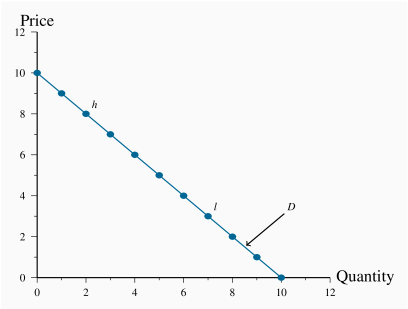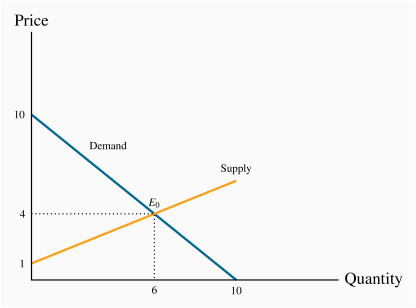The demand curve is a graphical expression of the relationship between price and quantity demanded, holding other things constant. Figure 3.1 measures price on the vertical axis and quantity on the horizontal axis. The curve D represents the data from the first two columns of Table 3.1. Each combination of price and quantity demanded lies on the curve. In this case the curve is linear—it is a straight line. The demand curve slopes downward (technically we say that its slope is negative), reflecting the fact that buyers wish to purchase more when the price is less.
To derive this demand curve we take each price-quantity combination from the demand schedule in Table 3.1 and insert a point that corresponds to those combinations. For example, point h defines the combination  , the point l denotes the combination
, the point l denotes the combination  . If we join all such points we obtain the demand curve in Figure 3.2.The same process yields the supply curve in Figure 3.2. In this example the supply and the demand curves are each linear. There is no reason why this linear property characterizes demand and supply curves in the real world; they are frequently found to have curvature. But straight lines are easier to work with, so we continue with them for the moment.
. If we join all such points we obtain the demand curve in Figure 3.2.The same process yields the supply curve in Figure 3.2. In this example the supply and the demand curves are each linear. There is no reason why this linear property characterizes demand and supply curves in the real world; they are frequently found to have curvature. But straight lines are easier to work with, so we continue with them for the moment.
The demand curve is a graphical expression of the relationship between price and quantity demanded, with other influences remaining unchanged.
The supply curve is a graphical representation of the relationship between price and quantity supplied, holding other things constant. The supply curve S in Figure 3.2 is based on the data from columns 1 and 3 in Table 3.1. It has a positive slope indicating that suppliers wish to supply more at higher prices.
The supply curve is a graphical expression of the relationship between price and quantity supplied, with other influences remaining unchanged.
The demand and supply curves intersect at point E0, corresponding to a price of $4 which, as illustrated above, is the equilibrium price for this market. At any price below this the horizontal distance between the supply and demand curves represents excess demand, because demand exceeds supply. Conversely, at any price above $4 there is an excess supply that is again measured by the horizontal distance between the two curves. Market forces tend to eliminate excess demand and excess supply as we explained above. In the final section of the chapter we illustrate how the supply and demand curves can be 'solved' for the equilibrium price and quantity.




